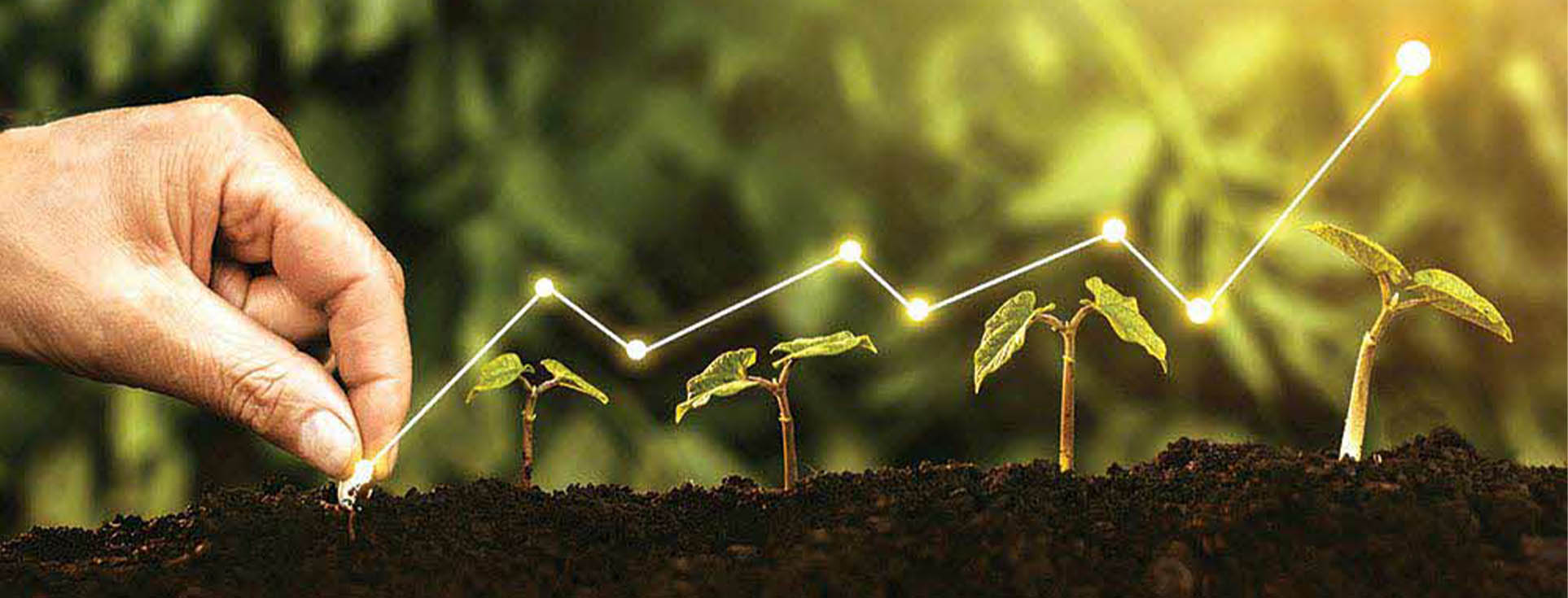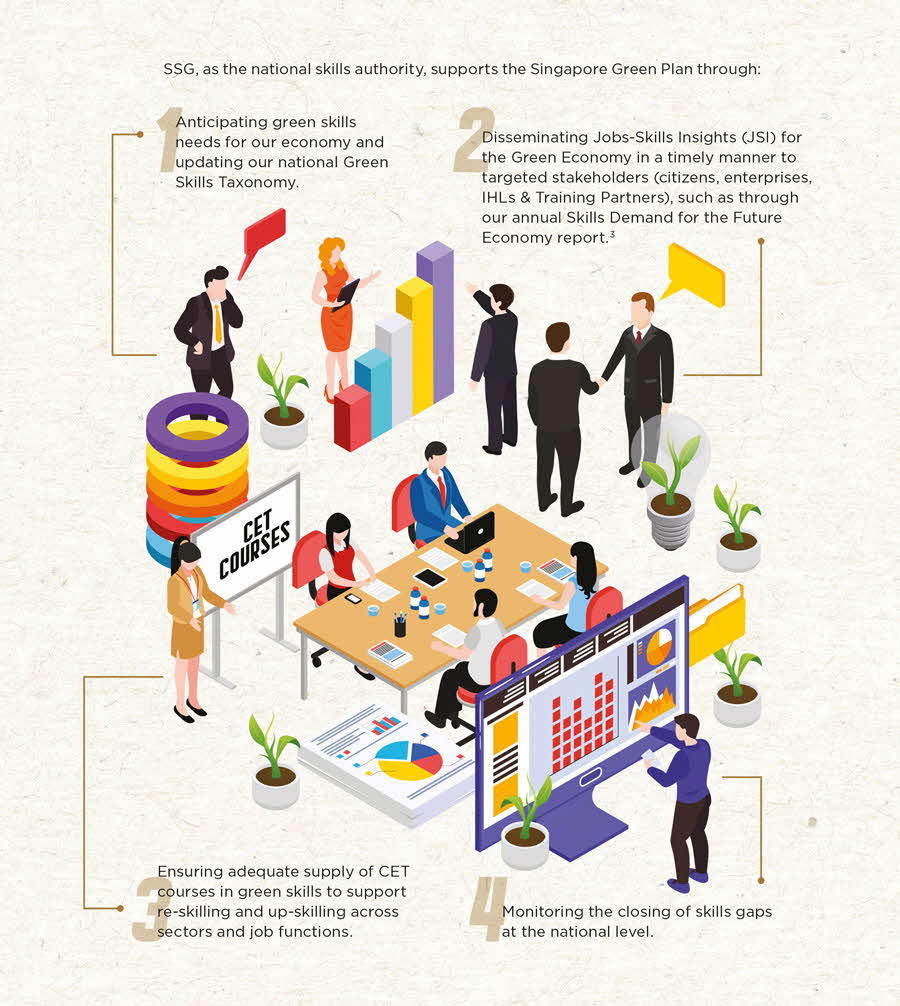Skilling Up for a Green Future
ETHOS Issue 24, August 2022

The world is gearing up to take action to address climate change as well as environmental and resource sustainability. What economic opportunities does this represent for Singapore?
The Singapore Green Plan details the nation’s ambition to leverage the global green agenda to achieve growth, transformation and sustainability objectives.1 This is a purposeful transformation to be sustainable and competitive. We expect to see the green wave touch every job (a.k.a., greening of current jobs). Different work functions from branding and marketing, to communications, finance, engineering, and operations will need to embrace new knowledge, understand market demand and design processes, and products to support green demand.
Given that a skilled workforce is a key enabler for Singapore’s Green Economy Strategy, there is a need to act quickly and early to capture opportunities, especially in new growth areas such as agritech, carbon services and trading, electric vehicles, green finance, clean energy, circular economy and resource optimisation, and sustainable tourism.
Other initiatives, while nascent, such as Climate Impact X (CIX)—a global carbon exchange and marketplace, and APAC’s first sustainable aviation fuel (SAF) plant being built in Tuas, will give Singapore a competitive advantage to maintain its hub and R&D position.
What is the state of Singapore's green sector today? Where do you see the greatest potential for development?
Progressive sectors in Singapore’s green agenda include Built Environment, Clean Energy, Hospitality, Manufacturing, and Water. The Building Construction Authority’s Green Mark has spurred the Built Environment sector to promote and facilitate green buildings and design sustainability since 2005. Some of Singapore’s prominent land developments, like the Gardens by the Bay and Marina Bay Sands, are examples of biophilic design, focusing on integrating nature with the built environment.
The Singapore Tourism Board, together with the Singapore Hotel Association and its member hotels, have also been innovatively managing their energy costs, food waste and chemical usage. Manufacturing companies are also leading in sustainable manufacturing technologies and practices, from sustainable product design to ethical sourcing, sustainable packaging, and energy transition. Singapore’s water treatment is ranked among the world’s best in the innovative method of desalinating sea water, including NEWater. These are clear examples of how Singapore has been active in embracing Environmental- Social-Governance (ESG) goals.
While Net Zero steals the headlines, we should not neglect newer green efforts. For example, Agri-Tech, Aqua-Tech, and Alternative Protein Production developments are exciting areas to follow. We recently witnessed Eat Just opening their lab-grown meat facility that will produce lab-grown chicken, and Shiok Meats winning awards for its lab-grown seafood like shrimp and crab. Next Gen Foods, a plant-based food company, recently raised USD$100 million in series-A funding. We have even set up SGProtein and FoodPlant, sharing R&D, manufacturing and distribution ecosystems for companies to trial new products and scale production.
These efforts also support our food security 30 by 30 agenda to build up Singapore’s agri-food industry’s capability and capacity to produce 30% of our nutritional needs locally and sustainably by 2030.2
The greatest potential for us is using Singapore as a R&D lab and launch-pad to export the innovative capability, knowhow and skills developed in Singapore to the world. This has always been our modus operandi: seeing the world market as the hinterland.
There is a need to act quickly and early to capture opportunities, especially in new growth areas.
What skillsets, capacities and mindsets will Singapore need to grow our green sector and attain our own sustainability goals?
In past decades, Singapore has gone through two rounds of mass-skilling: in the 1990s, we pushed out a national computer programme to acquaint our citizens with the use of computers. Again, in the mid-2000s, we pushed out national programmes on digital literacy (e.g., use of e-payment, apps) to support mass-skilling of foundational skills. For green skills, SSG will continue the effort in broad-skilling citizens and the workforce in foundational knowledge and awareness of the green economy, while ensuring an adequate supply of upskilling opportunities in vertical sectors and business functional areas.
From our data analysis, the impact on jobs and skills will primarily be through the ‘greening’ of current jobs—existing job content and tasks performed will change as businesses incorporate green technologies and make their business practices more sustainable. New knowledge in different aspects of the green economy will become part of work requirements in time to come, including in horizontal functions such as Branding & Marketing, Finance, Procurement, and Human Resource. New job roles such as Digital Sustainability Lead, Sustainability Engineer and Sustainability Manager will see increasing hiring demand.
Singapore has the right skills ecosystem— from R&D at corporate laboratories in our universities to Centres of Innovation in the polytechnics—to support frontier R&D innovation and translation of science and technology applications in the economy. Hence, our polytechnics and universities are major players in supporting R&D and its translation to the workplace and marketplace: a critical part of the value chain. The R&D and Proof-of-Concept projects happening across various industries are essential to inform us of potential job content changes and emerging skills demand.
On top of R&D, the Continuing Education & Training (CET) ecosystem under the charge of SSG will facilitate the acquisition of targeted skills for enterprises to adopt new business models and processes, to capitalise on the green agenda.

How will shifting public attitudes, consumer behaviours and changing lifestyles impact support for and adoption of green tech and measures?
Greater public awareness of the carbon footprint and environmental impact of our lifestyles and consumption behaviour will shape the overall adoption of the green agenda. We are beginning to see more businesses jumping in to shift consumption behaviour and provide more sustainable options, e.g., SPECO (environmental friendly cleaning), BarePack (sustainable food delivery), Decathlon (bring your own bag), FairPrice (support local produce), etc. Over time, we believe these will become habits of choice.
At the same time, awareness programmes mounted by the Ministry of Sustainability and Environment concerning rising sea levels, and the other public communications efforts (e.g., the CNA Green Plan) will help shape the public’s attitude towards responsible consumption.
The greatest potential for us is to export the innovative capability, know-how and skills developed in Singapore to the world.
Paint us a picture of Singapore's prospects as we pursue urban sustainability in the years ahead.
I envisage a video showing a group of visitors entering a gallery (such as the URA City Gallery), standing in front of the big Singapore model. The gallery will showcase where the green innovations are being lived out by the citizens, participated in by the industries, and the exciting R&D taking place. The counters of our Net Zero achievements and other indicators (e.g., carbon footprint per capita) are featured in the exhibition, alongside another part showcasing Singapore-based solutions supporting other economies across the globe.
At an individual level, I hope to one day use apps developed by a local enterprise to help me keep track of my carbon footprint, from the mode of transportation used to the consumption of energy, the sources of my food and the restaurants/hawkers preparing the food. If we can gamify the experience and make it intuitive, coupled with the right incentives, it will help us accelerate a nation-wide change.
Existing job content and tasks performed will change as businesses incorporate green technologies and make their business practices more sustainable.
What should policymakers and the public sector bear in mind as we work towards our Green Plan goals?
Heeding insights from historians of technology,4 we have to pay attention to cultural acceptance of a new way of life. How do we co-create a society that takes joint responsibility for sustainable developmental growth? How do we manage trade-offs and inconvenience as part of our green transformation? How do we involve citizens in the transformation at home, at work, and within their community?
We are beginning to see more businesses jumping in to shift consumption behaviour and provide more sustainable options.
NOTES
- SG Green Plan, “Let’s Build A City of Green Possibilities Together”, accessed June 27, 2022, https://www.greenplan.gov.sg/.
- Singapore Food Agency, “30 by 30”, accessed June 27, 2022, https://www.ourfoodfuture.gov.sg/30by30.
- SkillsFuture, “Skills Demand for the Future Economy”, accessed June 27, 2022, https://www.skillsfuture.gov.sg/skillsreport.
- Society of The History of Technology, “SHOT Publications”, accessed July 5, 2022, https://www.historyoftechnology.org/publications/.

